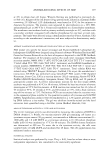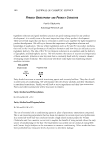EFFECT OF CELLULOSE POLYMERS ON DYE UPTAKE 109 was kept under stirring for a further 10 min. Finally, the pH of the resulting dyebath was corrected to 6.0 with the addition of 2-amino-2-methyl-propanol. Dyeing procedure. Dyeing was performed at room temperature (25° ± 1 ° C) by dipping a total amount of 0.9 g of the yak hair sample (ca. 8-9 cm in length divided into six hair tresses of 0.15 mg each) into a beaker containing 50.0 g of the chosen dyebath solution and then removing the hair tresses after a fixed time of 30 min. All the dyeing experi- ments were performed without stirring in order to avoid felting of the yak hair. The colored tresses were then rinsed with water. Washing. The dyed hair tresses were washed with a regular cleaning shampoo at 40° ± 1 °C from 30 to 45 s, and rinsed off. Finally, the washed tresses were dried with a hairdryer. The described procedure represented a single washing cycle. To obtain the data for this work, different washing cycles were performed. Color change was measured in tresses treated with semipermanent hair dyes after three, six, and nine washing cycles. The sample after the first washing cycle was used as control as it simulated a typical hairdresser dyeing procedure (dyestuff and first shampoo). Extraction procedure. A 50% (v/v) aqueous ethanol solution was used as an extracting medium, at room temperature, using an immersion time for the tresses of 30 s. Under these conditions, the extraction involves only the dyes present on the cuticle of the fiber (outer layer). A further extraction was carried out at room temperature with a similar solution by means of an ultrasound bath (US) for 3-5 hr. In this case, the extraction of the dye adsorbed into the cortex of the hair (inner layer) was also obtained. These procedures were employed for determining the dye amount on the fiber (inner and outer layers) after the dyeing process and the different washing cycles. UV-Vis and Color Measurement. The absorbance of the extracted dyes (after the dyeing process and the third, sixth, and ninth washing treatments, respectively) was monitored using a Cary lE Varian UV-Vis spectrophotometer. The different dye concentrations or moles were calculated using calibration curves obtained for each single dye in a 50% (v/v) aqueous ethanol solution: a linear relationship according to Beer's Law was found between absorbence and concentration for each dye studied. The total absorbance of the extracted solution containing HC Blue 2, Basic Red 51, and HC Yellow 2 (assuming that there is no interaction between the dyes in the mixtures) could be obtained by simple addition of the absorbance of the individual component at a given wavelength using the formula (12,13): A= I1Ax.= I1s i Ci Knowing the value of the molar extinction coefficient 8 i of the single dye at a selected A, the concentration of each component can be calculated by making measurements at a number of wavelengths equal to the amount of components present in the mixture, using the system: {Al = 81 * b * C1 A2 = 82 * b * C2 + 81 * b * C1 A 3 = s 3 * b * c 3 + 82 * b * c2 + 81 * b * c1 In our case the absorbance was measured at A 1 = 624.47 nm, A2 = 542.61 nm, and A3 = 390.71 nm for HC Blue 2, Basic Red 51, and HC Yellow 2, respectively these wavelengths were chosen comparing the spectra obtained for the single dye.
110 JOURNAL OF COSMETIC SCIENCE Colorimetric analysis on yak hair was conducted using a Lambda 35 UV-Vis-Nir Perkin Elmer instrument integrated with a Labsphere RSA-PE-20 reflectance and transmittance integrative sphere and a software color method (CIELAB scale L*, a*, b*, using CIED65/ 10° illuminant/observer condition). Yak hairs were assembled in the apposite Teflon support in such a way that the fibers were aligned and maximum overall smoothness was ensured. Three measurements of the same sample were registered, each time changing the fiber disposition to ensure that any change in the reflectance of the samples was not simply due to a non-uniformity of the yak hair sample preparation assembly the data reported represent the average of these measurements (14). From the L, a, and b values measured, the il.L a'nd il.C were calculated and were reported as lightness and color charge, respectively. The a value represents the green-to-red shift, the b value the blue-to-yellow shift. The total color difference (il.E), il.L, and il.C definitions are given below (15): il.C = [(at - aY -(bt -bY] 112 il.E = [(Lt -LJ2 + (at - aY + (bt -bY] 112 il.L = Lt - L0 The at b tJ L t data describe the final value obtained after the dyeing process or the different washing cycles a0, b0, L0 describe the non-colored yak hair, or alternatively, the initial dyed values (first washing cycle included). RESULTS AND DISCUSSION HAIR DYE UPTAKE The sorption of the dye mixture on yak hair was determined using an extraction procedure for the solution containing 0.1 % concentration of a different polymer. For comparison, the data obtained in the same experimental condition using a base dye solution (control) are reported. Each amount is the average value of three replicate adsorption experiments. Figure 1 shows the amount of the adsorbed dye mixture (ex- pressed as µmoles of uptake versus gram of hair) still present on the hair (inner and outer layer) after the dyestuff process. It can be seen that in the presence of a cationic polymer there is an increment of about 30% of the dye amount in the hair fiber, whereas no variation in the dye mixture was observed when a non-ionic polymer was employed (compared with the control). Cationic polymers are well known in the literature for their high degree of substantivity to hair (1). The driving force for this appreciable uptake could be ascribed to electrostatic interaction between the positively charged groups (cationic) of the polymers and the negative sites of the hair surface present at any pH above its isoelectric point (pH ca. 3.7). Moreover, cationic polymers have been shown to form both association complexes and/or hydrophobic interactions with dye (6). On the other hand, when neutral polymers are used, as the nature of the main binding with the hair fiber is of the polar and Van der Waals kind, they can be easily removed by shampoo, a good hydrogen-bond break- ing agent, with the consequent loss of anti-fading power (1). To monitor the effect of the different polymers on the dyes composing the mixture, an analysis of the extracted dyes relative to the outer and inner layers of the fiber was made. In Figure 2 are reported histograms relative to the amount ofHC Blue 2, Basic Red 51, and HC Yellow 2 uptake
Purchased for the exclusive use of nofirst nolast (unknown) From: SCC Media Library & Resource Center (library.scconline.org)






















































































